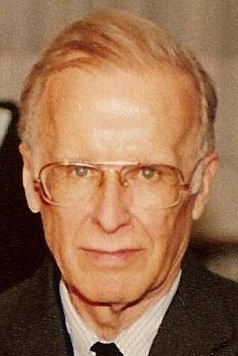John Backus facts for kids
Quick facts for kids
John Backus
|
|
|---|---|

Backus in December 1989
|
|
| Born |
John Warner Backus
December 3, 1924 |
| Died | March 17, 2007 (aged 82) |
| Alma mater | University of Virginia University of Pittsburgh Haverford College Columbia University (B.S. 1949, M.S. 1950) |
| Known for | Speedcoding FORTRAN ALGOL Backus–Naur form Function-level programming |
| Spouse(s) |
Marjorie Jamison
(m. 1947–1966)Barbara Una
(m. 1968; died 2004) |
| Children | 2 |
| Awards | National Medal of Science (1975) Turing Award (1977) Charles Stark Draper Prize (1993) |
| Scientific career | |
| Fields | Computer science |
| Institutions | IBM |
John Warner Backus (December 3, 1924 – March 17, 2007) was an American computer scientist. He led the team that created FORTRAN. This was the first widely used high-level programming language.
Backus also invented the Backus–Naur form (BNF). This is a special way to describe how programming languages are structured. Later, he researched a different way of programming called function-level programming. He shared his ideas in his famous 1977 Turing Award speech.
The IEEE gave Backus the W. W. McDowell Award in 1967. This was for his work on FORTRAN. He received the National Medal of Science in 1975. In 1977, he won the Turing Award. This award recognized his important contributions to designing practical programming systems. It also honored his work on formal ways to describe programming languages.
Backus retired in 1991. He passed away at his home in Ashland, Oregon on March 17, 2007.
Contents
Early Life and Education
Backus was born in Philadelphia. He grew up in Wilmington, Delaware. He went to The Hill School in Pottstown, Pennsylvania. He was not a very focused student there.
He started college at the University of Virginia to study chemistry. But he struggled with his classes. He was asked to leave after less than a year. This was because he didn't attend classes enough.
During World War II, he joined the U.S. Army. He became a corporal. He was in charge of an anti-aircraft battery in Fort Stewart, Georgia.
After doing well on a military test, the Army sent him to study engineering. He went to the University of Pittsburgh. Later, he moved to a pre-medical program at Haverford College.
While working at a hospital, doctors found a bone tumor in his head. It was removed successfully. A metal plate was put in his head. He then went to medical school at the Flower and Fifth Avenue Medical School. But he found it boring and left after nine months.
He had another surgery to replace the metal plate. He designed the new plate himself. In 1946, he was honorably discharged from the U.S. Army.
Creating FORTRAN
After moving to New York City, Backus first trained as a radio technician. He then became very interested in mathematics. He earned his bachelor's degree in 1949 from Columbia University. He got his master's degree in 1950, both in mathematics.
In 1950, he joined IBM. For his first three years, he worked on the Selective Sequence Electronic Calculator (SSEC). His first big project was to write a program to calculate the Moon's positions.
In 1953, Backus created a language called Speedcoding. This was the first high-level language made for an IBM computer. It helped make software development easier.
Programming was very hard in the 1950s. In 1954, Backus put together a team. Their goal was to create Fortran for the IBM 704 computer. FORTRAN was the first high-level programming language to be used widely. This language made computers much more useful. It allowed scientists and others to use computers without needing to know a lot about how the machines worked.
Backus–Naur Form (BNF)
Backus was part of international groups that developed ALGOL 58 and ALGOL 60. ALGOL 60 became a very important standard for sharing algorithms worldwide.
Backus created the Backus–Naur form (BNF). He published it in a UNESCO report about ALGOL 58. BNF is a formal way to describe any programming language. It was very important in the history of creating compilers. Compilers are programs that translate code into instructions computers can understand.
Some other ways were tried, like in Lisp and APL. But by the 1970s, BNF became the standard for describing computer languages. This helped Backus win the Turing Award in 1977.
Function-Level Programming Ideas
Later in his career, Backus worked on a different way of programming. It was called function-level programming. He described it in his Turing Award speech. The speech was titled "Can Programming be Liberated from the von Neumann Style?".
Some people thought this paper was Backus saying sorry for creating Fortran. But it mostly made people interested in functional programming in general. When Backus talked about function-level programming, his ideas were often misunderstood. People thought it was the same as traditional functional programming languages.
Backus's ideas were inspired by Kenneth E. Iverson's APL. He spent the later part of his career developing FL. This was a new version of his function-level ideas. FL was an internal IBM research project. The project ended when the language development stopped.
Awards and Honors
- Named an IBM Fellow (1963)
- W. W. McDowell Award (1967)
- National Medal of Science (1975)
- Turing Award (1977)
- Fellow of the American Academy of Arts and Sciences (1985)
- Doctor honoris causa from Université Henri-Poincaré (1989)
- Draper Prize (1993)
- Computer History Museum Fellow Award (1997) for his work on FORTRAN and computer systems.
- Asteroid 6830 Johnbackus named after him (June 1, 2007)
See also
 In Spanish: John Backus para niños
In Spanish: John Backus para niños

